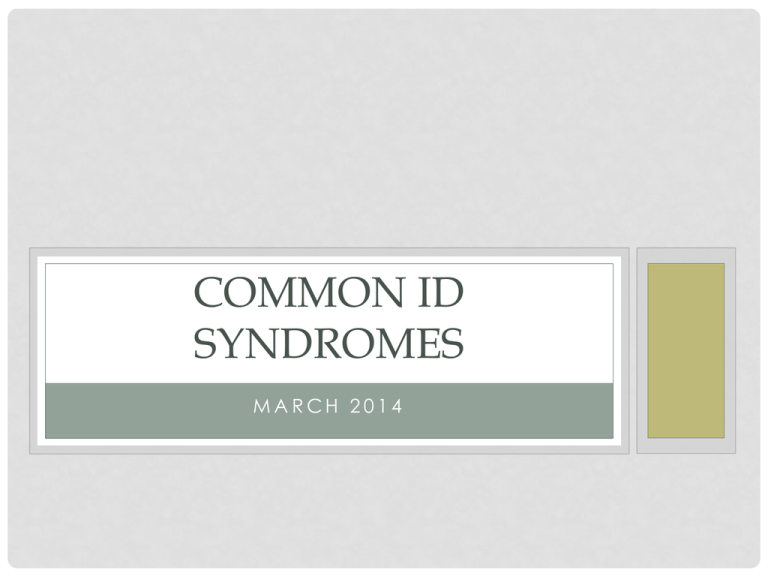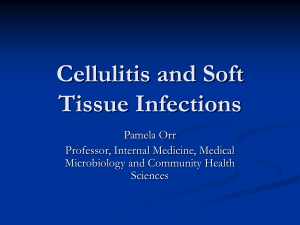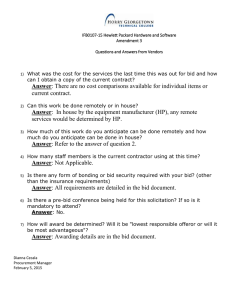COMMON ID SYNDROMES
advertisement

COMMON ID SYNDROMES MARCH 2014 OBJECTIVES • Identifying the bug • Choosing the antibiotics • Empiric coverage for common ID scenarios BASICS • Try to collect cultures before starting antibiotics • Renally dose antibiotics (esp Vanco, levaquin) • Call the ID fellow for approval when required • Use Sanford Guide and hospital antibiograms • Sanford Guide now has a mobile app • Epocrates app also has useful guides Consider your bugs! What are you treating or covering empirically? COMMON ID SYNDROMES (COVERED IN THIS LECTURE) • • • • • • Bacterial Meningitis Infective Endocarditis Clostridium Difficile Urinary Tract Infections Cellulitis CAP & HCAP (covered elsewhere) BACTERIAL MENINGITIS • Common causes of meningitis: • • • • S. pneumoniae (30-50%) Neisseria meningitidis (10-35%) Listeria (2-11%) Other less common include: • Gram-negative; Streptococci; Staphylococci; H. influenzae • Diagnosis: LP • Gram stain, C&S, cell count w/ diff, protein, and glucose • Empiric treatment for Suspected Bacterial Meningitis • 3rd gen cephalosporin (ceftriaxone or cefotaxime), PLUS • Vancomycin, +/• Ampicillin (if at risk for Listeria: age >60 or neonate) INFECTIVE ENDOCARDITIS • Obtain 3 sets of blood cultures • Diagnosis: Modified Duke Criteria • Definite endocarditis: • • • • Pathologic evidence of disease OR 2 Major clinical criteria OR 1 Major + 3 minor OR 5 minor • Possible endocarditis • 1 Major + 1 minor OR • 3 minor IE MAJOR AND MINOR CRITERIA • Major Criteria • 1) Positive blood cultures (specific criteria) • “Typical” organisms: S. aureas, viridans strep, S. Bovis, enterococci, and HACEK • 2) Abnormal echocardiogram • Minor Criteria • • • • • 1) Predisposing condition (valve disease or IVDA) 2) Fever 3) Vascular phenomena 4) Immunologic phenomena 5) Positive blood culture that does not meet a major criterion TREATMENT OF IE Organisms Susceptibility Drug Regimen Duration Viridans streptococci, S. Bovis PCN-sensitive PCN G or CTX 4 weeks Prosth >4 weeks (PCN G or ctx) + gent 2 weeks Vancomycin (alt) 4 weeks PCN-resistant Increased dose PCN G 4 weeks S. Aureus or Coagulase-neg Methicillin-susc Nafcillin Methicillin-resis Vancomycin 6 weeks Prosthetic (add rifampin & gent) Staph, uncomplicated rightsided Methicillin-susc Nafcillin + gentamicin or daptomycin 2 weeks Enterococci PCN-sens (PCN G or amp or vanc) + gent 4-6 weeks Prosth = 6 weeks Amp + PCN + Vancresis Very specialized Very specialized Ceftriaxone 4 weeks Prosth = 6 weeks HACEK DIARRHEA DUE TO C. DIFFICILE • Common causes: • Clindamycin, cephalosporins, quinolones • Diagnosis: • Confirm with stool assay for cytotoxin • Recommendations: • • • • • Mild-to-moderate: Flagyl 500mg po tid x 10-14 days Severe disease: Vanco 125mg po qid x 10-14 days Severe with complications: P.O. Vanco +/- IV Flagyl 1st relapse: Repeat the first regimen 2nd relapse: Vanco 125mg po qid and taper URINARY TRACT INFECTION • Microbiology for uncomplicated UTI: • E. coli (most common 75-95%) • Other species of Enterobacteriaceae: • Proteus mirabilis (associated with stones, do add’l workup) • Klebsiella pneumoniae • Staphylococcus saprophyticus • Group B strep (in pregnant women, otherwise contaminant) • Likely contamination in healthy non-pregnant individuals: • (lactobacilli, enterococci, coag-neg staph) URINARY TRACT INFECTION • Acute uncomplicated cystitis-urethritis • Bactrim 160/800 (1 DS tab) bid x 3 days OR • Macrobid 100mg bid x 5 days OR • Fosfomycine 3g po (single dose) • Uncomplicated pyelonephritis • Ciprofloxacin 500mg bid x7 days OR • Ceftriaxone or quinolone (if requiring IV) • Complicated pyelonephritis • Ceftriaxone, cefepime, aztreonam, or quinolone • Add expanded coverage if ICP or urinary obstruction CELLULITIS • Purulent (drainage or exudate w/o drainable abscess) – d/t community-acquired MRSA • • • • • Clindamycin 300-450mg po tid Bactrim 1 DS tab bid Doxycycline 100mg bid Minocycline 200mg x1, then 100mg bid Linezolid 600mg bid • Non-purulent – d/t beta-hemolytic strep and MSSA PO Dicloxacillin 500mg q6h IV Cefazolin 1-2g q8h Keflex 400mg q6h +/- Bactrim Oxacillin 2g q4h Clindamycin 300-450mg q6h Nafcillin 2g q4h Clindamycin 600-900mg q8h ANTIBIOTIC COVERAGE QUICK GUIDE • 1. Pseudomonas: • Zosyn • Aminoglycosides • Cephalosporins: Ceftazidine, Cefepime • Fluoroquinolones: Cipro, Levaquin • Carbipenems: Imipenem, Meropenem • Aztreonam • Colistin 2. Anaerobes: Flagyl Clindamycin Zosyn Unasyn Augmentin Carbipenem Moxifloxacin Tigecycline 3. MRSA: Bactrim Clindamycin Doxycyclin Vancomycin Linezolid Tigecycline Daptomycin – cannot use in lungs! 4. VRE: Linezolid Tigecycline Daptomycin TAKE HOME POINTS • Deescalate antibiotics based on sensitivities • Antibiotics should be individualized based on patient circumstances (allergy, tolerability, compliance), local community resistance prevalence, availability, cost, and patient and provider threshold for failure




